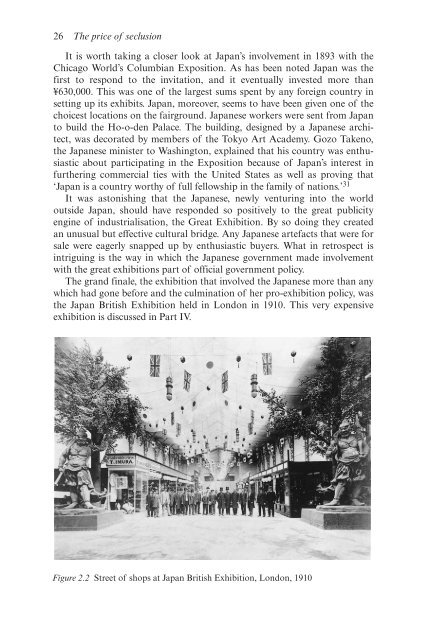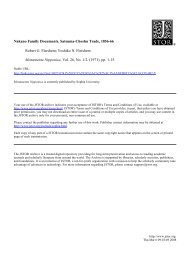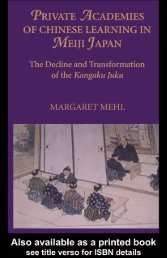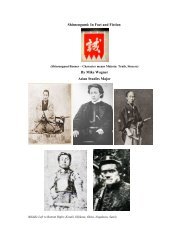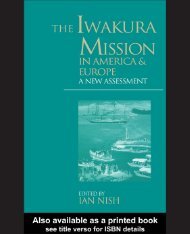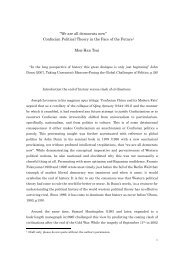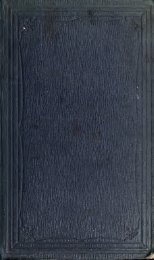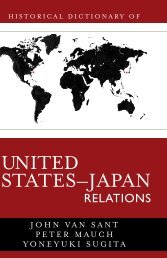- Page 4 and 5: Japan and Britainafter 1859Creating
- Page 6: ForN.T. and S.T.With affection
- Page 9 and 10: viiiContentsPART IIIIn Britain 1099
- Page 11 and 12: xIllustrations1.7 Coats 2 61.8 Coat
- Page 13 and 14: xiiPrefaceStrenuous efforts were ma
- Page 15 and 16: xivPrefaceThe debts incurred in pre
- Page 17 and 18: Figure 1.1 Samurai, clumsily dresse
- Page 19 and 20: 4 The price of seclusionUnder the g
- Page 21 and 22: 6 The price of seclusionFigure 1.6
- Page 23 and 24: Figure 1.11 JacketFigure 1.12 Trous
- Page 25 and 26: 10 The price of seclusionThe Figure
- Page 27 and 28: 12 The price of seclusionto reach n
- Page 29 and 30: 2 The Great Exhibition asa cultural
- Page 31 and 32: 16 The price of seclusionEmpire. It
- Page 33 and 34: 18 The price of seclusionIt was fol
- Page 35 and 36: 20 The price of seclusioncreated a
- Page 37 and 38: 22 The price of seclusionwho was to
- Page 39: 24 The price of seclusionThe inspir
- Page 43 and 44: 28 The price of seclusion19 Fukuzaw
- Page 45 and 46: 30 The price of seclusioneffectivel
- Page 47 and 48: 32 The price of seclusionitself sel
- Page 49 and 50: 34 The price of seclusionfor it. Ot
- Page 51 and 52: 36 The price of seclusionThe Japane
- Page 53 and 54: 38 The price of seclusionIt should
- Page 55 and 56: 40 The price of seclusionEven if th
- Page 59 and 60: 44 The price of seclusionBamboo was
- Page 61 and 62: 46 The price of seclusionFigure 4.1
- Page 63 and 64: 48 The price of seclusionside, quic
- Page 65 and 66: 50 The price of seclusionSeveral of
- Page 67 and 68: 52 The price of seclusionThe United
- Page 69 and 70: 54 The price of seclusionTable 4.8
- Page 72: Part IIIn Japan
- Page 75 and 76: 60 In JapanThe original store was f
- Page 77 and 78: 62 In JapanBooks in English availab
- Page 79 and 80: 64 In JapanTable 5.1 continuedFawce
- Page 81 and 82: 66 In JapanRedesdale’s Tales of O
- Page 83 and 84: 68 In JapanIt may be that the large
- Page 85 and 86: 70 In JapanSmith, Adam, An Inquiry
- Page 87 and 88: 72 In Japan6 Maruzen Hyakunenshi [1
- Page 89 and 90: 74 In Japanall he could about his a
- Page 91 and 92:
76 In Japanproduced a mammoth paper
- Page 93 and 94:
78 In Japantomb at Okamoto 2-33, Se
- Page 95 and 96:
80 In JapanThe house has been descr
- Page 97 and 98:
82 In Japana commanding mass of red
- Page 99 and 100:
84 In JapanDuring the course of the
- Page 101 and 102:
7 Christopher Dresser andindustrial
- Page 103 and 104:
88 In JapanCutler also quotes from
- Page 105 and 106:
90 In Japanwas the Prince Consort
- Page 107 and 108:
92 In JapanAs Dresser reported on h
- Page 109 and 110:
94 In Japanwere, for his hosts, hea
- Page 111 and 112:
8 Paintings, photographsand printsA
- Page 113 and 114:
98 In JapanThere is a sense in whic
- Page 115 and 116:
100 In JapanHyakutake Kaneyuki (184
- Page 117 and 118:
102 In JapanJapan. East’s paintin
- Page 119 and 120:
104 In Japanavailable in Britain, w
- Page 121 and 122:
106 In Japandamp sheet of paper. Th
- Page 123 and 124:
108 In Japan7 Sato and Watanabe, Ja
- Page 126 and 127:
9 Japonisme for allJaponisme 1 has
- Page 128 and 129:
Japonisme for all 113bristling with
- Page 130 and 131:
Japonisme for all 115many famous pa
- Page 132 and 133:
was proud of his Scottish roots, an
- Page 134 and 135:
Japonisme for all 119style that bec
- Page 136 and 137:
Figure 9.2Duke and Duchess ofConnau
- Page 138 and 139:
Japonisme for all 1237 See also W.
- Page 140 and 141:
10 Collecting Japanese artFrom the
- Page 142 and 143:
Collecting Japanese art 127(1845-19
- Page 144 and 145:
James Lord BowesCollecting Japanese
- Page 146 and 147:
There can be no doubt of Bowes’s
- Page 148 and 149:
Angst and acrimonyCollecting Japane
- Page 150 and 151:
Collecting Japanese art 135When I t
- Page 152 and 153:
Collecting Japanese art 137Presente
- Page 154 and 155:
Collecting Japanese art 13928 Orcha
- Page 156 and 157:
Menpes, Hornel, Brangwyn 141During
- Page 158 and 159:
members of the burgeoning group of
- Page 160 and 161:
Menpes, Hornel, Brangwyn 145althoug
- Page 162 and 163:
Menpes, Hornel, Brangwyn 147Figure
- Page 164 and 165:
‘It is very cold. Snow lying abou
- Page 166 and 167:
Menpes, Hornel, Brangwyn 151Japanes
- Page 168 and 169:
which were selling at low prices’
- Page 170 and 171:
Menpes, Hornel, Brangwyn 15528 See
- Page 172 and 173:
ingly prosperous British public for
- Page 174 and 175:
Travel writing about Japan 159publi
- Page 176 and 177:
Travel writing about Japan 161other
- Page 178 and 179:
The text of over 200 pages was ‘t
- Page 180 and 181:
Travel writing about Japan 165illus
- Page 182:
Travel writing about Japan 16726 C.
- Page 186 and 187:
13 The Japan British Exhibition,Lon
- Page 188 and 189:
The Japan British Exhibition, Londo
- Page 190 and 191:
The Japan British Exhibition, Londo
- Page 192 and 193:
The Japan British Exhibition, Londo
- Page 194 and 195:
The Japan British Exhibition, Londo
- Page 196 and 197:
orders for Japan, and from the many
- Page 198 and 199:
ain in front of and above the ear.
- Page 200 and 201:
14 Shopping for JaponoiserieIt was
- Page 202 and 203:
Shopping for Japonoiserie 187Japane
- Page 204 and 205:
Shopping for Japonoiserie 189rave a
- Page 206 and 207:
Shopping for Japonoiserie 191A larg
- Page 208 and 209:
Even since I first came to England
- Page 210 and 211:
Shopping for Japonoiserie 195potter
- Page 212:
Part VFour bridge builders
- Page 215 and 216:
200 Four bridge buildersso close an
- Page 217 and 218:
202 Four bridge buildersWithin thre
- Page 219 and 220:
204 Four bridge buildersfriend and
- Page 221 and 222:
206 Four bridge buildersso long as
- Page 223 and 224:
208 Four bridge buildersFigure 15.2
- Page 225 and 226:
210 Four bridge buildersto him glaz
- Page 227 and 228:
212 Four bridge builders30 Hatcher,
- Page 229 and 230:
214 Appendix ISuya Kinhei, Vaniquch
- Page 231 and 232:
Appendix IIIndustrial art manufactu
- Page 233 and 234:
218 Appendix IITokyoJune 1883Yugyok
- Page 235 and 236:
220 Appendix IIIPainting (Fine Arts
- Page 237 and 238:
222 Appendix III17 titlesW. Heffer
- Page 239 and 240:
Select bibliographyThe place of pub
- Page 241 and 242:
226 Select bibliographyConant, E.P.
- Page 243 and 244:
228 Select bibliographyGlasgow City
- Page 245 and 246:
230 Select bibliographyLiberty’s,
- Page 247 and 248:
232 Select bibliography—— The C
- Page 249 and 250:
234 IndexChinese aesthetics 203Chin
- Page 251 and 252:
236 IndexMatsudaira, Baron Masana 1


